Feeling cooped up from quarantine? It’s the perfect season to get outside and enjoy nature
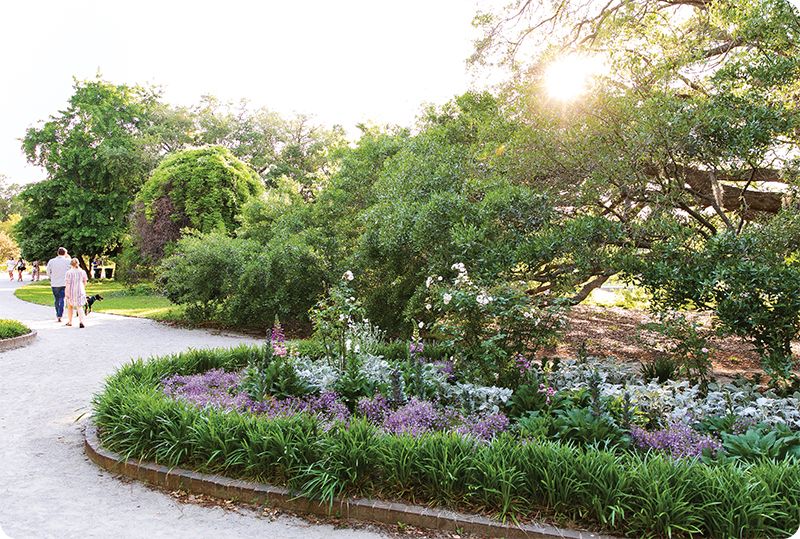
Happily, we’re surrounded by public land, from the Francis Marion National Forest to the ACE Basin, plus an incredible network of county and city parks and the state’s only national park in the Midlands. Each destination allows for social distancing while experiencing the great outdoors. Some require a short drive, while others may be just around the corner. C’mon, let’s go!
1. Hampton Park
Longtime Charlestonians remember when downtown’s Hampton Park (pictured above) had a zoo (young folks, ask your parents). But in the 19th century—well before it was home to a lion and a herd of goats—the present-day park was a horse track. Today, joggers and bikers tackle the one-mile loop in place of thoroughbreds.
The horse-racing era ended with the Civil War, when the Italianate grandstand and infield became a prisoner-of-war camp for captured Union soldiers and gravesite for the more than 250 who died there. After the war, upwards of 10,000 freedpeople gathered here to honor the fallen Union soldiers, a legacy that makes Hampton Park an especially appropriate place for the annual finale of the MOJA Arts Festival, which celebrates African American and Caribbean culture.
Today, the original racetrack’s gates are at Belmont Park in New York, and the 60-acre park’s animals are mostly limited to squirrels and wild geese in the pond. A physical fitness trail and jogging path parallel Mary Murray Boulevard, which is closed to traffic on Tuesday, Thursday, and Saturday mornings to allow runners and walkers to use the road without dodging cars. But you don’t have to come here to exercise—easy parking, a playground, restrooms, and picnic tables make Hampton Park the perfect in-town getaway for a family outing or just a lazy afternoon with a good book.
Take a peaceful stroll through Hampton Park:
30 Mary Murray Dr., downtown
Miles from Marion Square: 2
Admission: free
Amenities: parking, public restrooms, picnic tables, free Wi-Fi access
Learn more: charlestonparksconservancy.org/park/hampton-park
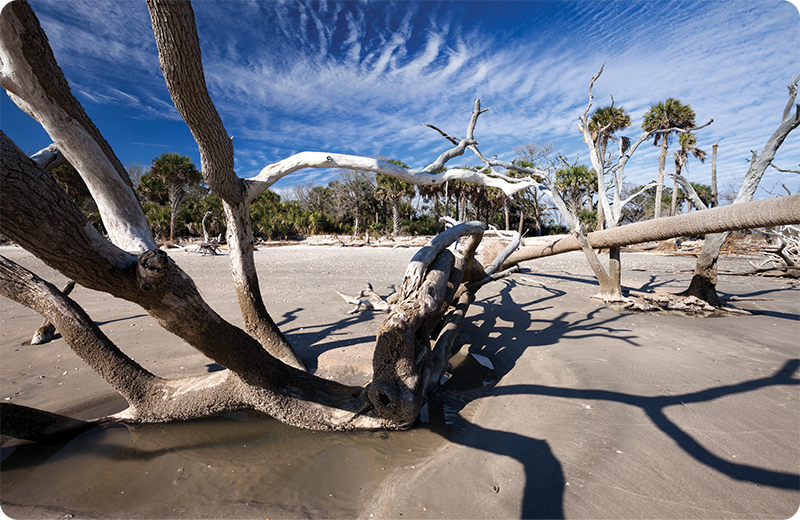
2. Botany Bay Plantation Heritage Preserve
Botany Island has a unique historical connection to Hampton Park—when the downtown zoo was closed, its goat population was set free on Botany, helping to keep the underbrush clear. Today, the goats are gone, and the former Botany Bay Plantation is a state-run public preserve. It’s also one of the most accessible spots to explore the ACE Basin.
The highlight of a visit is the boneyard beach that grew significantly after Hurricane Matthew in 2016. It’s accessible via a half-mile trail that crosses the marsh and a hammock island. At high tide, the skeletons of a former forest emerge from the surf. At low tide, they’re open for exploration. Bring water and snacks for the nearly three-mile walk up the beach to Botany Island, spotting fist-sized whelk shells along the way. (Note: shell collecting is prohibited, and high ground here, a critical shorebird nesting area, likely will be roped off during nesting season.)
Back at the former plantation, tour the six-and-a-half-mile driving loop with the windows down, or better yet, on bicycles. Historical sites include an original US Coast Guard survey line and plantation outbuildings. There’s also Jason’s Lake (open for catch-and-release fishing on Fridays, Saturdays, and Sundays).
Keep in mind that horses and dogs are not allowed on the beach or the trail to the beach, and that the preserve is closed on Tuesdays and for scheduled hunts.
1066 Botany Bay Rd., Edisto Island
Miles from Marion Square: 43.6, approximately one hour driving
Admission: free; obtain a day-use pass at the kiosk located at the main gate
Amenities: none
For up-to-date closings and info: www2.dnr.sc.gov/ManagedLands/ManagedLand/ManagedLand/57

3. Audubon Swamp Garden at Magnolia Plantation
Just minutes from West Ashley, the last of the country’s large-scale romantic gardens awaits exploration. Meander past camellias and azaleas galore along the pathways; there’s something in bloom every season. But for a wilder, authentically “Lowcountry” experience, don’t miss the 60-acre swamp garden.
Its namesake, John James Audubon, visited prior to the Civil War to witness the abundant bird population. Egrets and herons stalk the water for prey, while gators reveal their snouts through a thick layer of green duckweed on the pond’s surface. Wide earthen causeways and raised boardwalks weave between cypress trees emerging from the primordial goo. When the weather warms after winter, expect to see frogs, snakes, and even otters on the move.
Boardwalks wind around blackwater cypress and tupelo trees in the 60-acre swamp garden, where all manner of wildlife—from herons, egrets, and anhingas to alligators and otters—can be spied. Fun fact: the property served as a backdrop for the 1982 film, Swamp Thing.
3550 Ashley River Rd.
Miles from Marion Square: 12.1 Admission: $20, $10 kids ages six to 12, plus an additional $8 ticket for the swamp
Amenities: restrooms, a gift shop, takeout from the Peacock Cafe, and tram and boat tours at an additional cost
Learn more: magnoliaplantation.com

4. Woodlands Nature Reserve
The 6,000-acre Woodlands Nature Reserve, across from Middleton Place, hid in plain sight for years as private land used for dirt mining and fox hunting. Today, the pits left by the mines are beautiful lakes, and the majestic live oak groves that surround them are open to the public for hiking, biking, paddling, and camping. A day pass admits a vehicle of visitors, who can then explore via foot, bike, paddleboard, or kayak (bring your own or rent for $25).
Camping options include tent sites, RV hookups, and glamping in platform tents with king-size beds. Amenities continue to expand—there’s plenty to fill a long weekend: guided horseback trail rides, eBike tours that explore the distant reaches of the property, sailing lessons, disc golf, and kayak tours through the blackwater cypress swamp. Woodlands also hosts festivals and concerts that let patrons explore by day before rocking out at night. The Illuminated event on March 6 features colorful light displays among the trees with live jazz-rock music from Pierce Alexander.
Visit the nature reserve:
4279 Ashley River Rd.
Miles from Marion Square: 15.1
Admission: $30 per vehicle
Amenities: portable toilets for day-use guests
Learn more: woodlandsnaturereserve.com

5. ACE Basin National Wildlife Refuge
One of the country’s largest undeveloped estuaries, the ACE Basin is best explored by water, but a few spots—like the Ernest F. Hollings ACE Basin National Wildlife Refuge—offer the chance to get deep into the wilderness on foot or by bike. The circa-1828 Grove Plantation home serves as refuge headquarters, with grass roads and earthen dikes from former rice fields extending into the woods and marsh. During cooler months, this is a wonderfully quiet place to spend an entire day walking or biking (stubby-tire mountain bikes only).
Green Pond and Perimeter Pond are havens for birdlife. Blinds allow visitors to hide from sight and watch the avian spectacle, especially at sunrise and at dusk as birds return to roost.
Discover the ACE Basin:
8675 Willtown Rd., Hollywood
Miles from Marion Square: 33.8
Admission: free
Amenities: parking and restrooms
Learn more: fws.gov/refuge/ace_basin
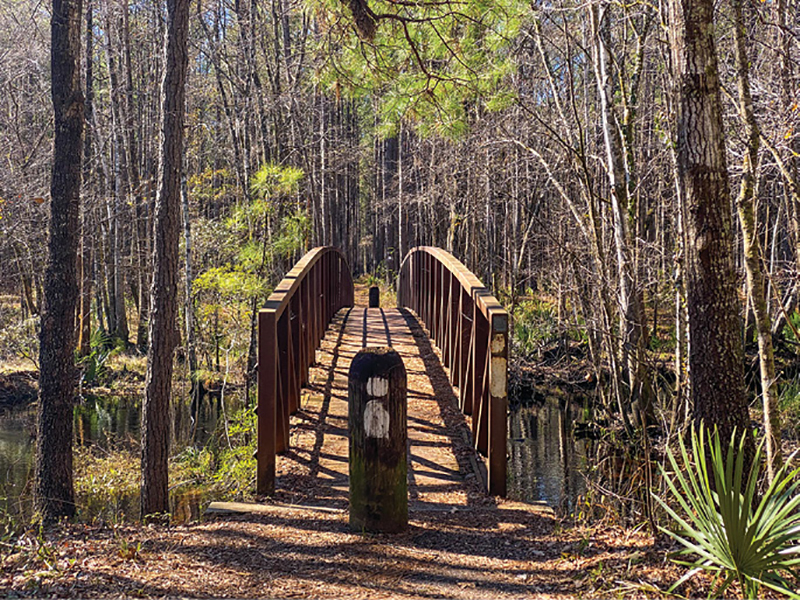
6. Swamp Fox Passage of the Palmetto Trail
You don’t have to drive to the mountains for an overnight backpacking trip. The Palmetto Trail’s Swamp Fox Passage runs 48 miles through the heart of the Francis Marion National Forest, passing Carolina bays, crossing creeks, and winding through tall stands of longleaf pine.
Recruit a friend and drop a car for a shorter one-way hike. Cane Gully Road to Witherbee Road near Moncks Corner allows for a five-mile walk. Closer to Mount Pleasant, Steed Creek Road to Halfway Creek Road is four miles. Trail maps are available at the Palmetto Conservation website.
Fall through spring are ideal seasons to hike the Swamp Fox Passage. By June, standing water often makes trails soggy. At all times, be prepared for mosquitos and keep a sharp eye out for snakes.
Miles from Marion Square: 29.2 to the trailhead on Hwy. 17
Admission: free
Amenities: parking, primitive camping (permits required), and canoe launch as specified on the trail map
Learn more: palmettoconservation.org

7. St. Christopher Camp & Conference Center
Maritime forests are increasingly rare, but at this private tract, you can walk directly from a stand of pine into the scrubby dune ecosystem and out onto the beach—a stunning transition. Here, a network of trails wind through the 314-acre forest. Highlights include a rope bridge over a seasonal creek, a ridgeline trail over a Colonial-era impoundment, and a dock overlooking the marsh around the North Edisto River. There’s also a boardwalk through a slough where wading and migratory birds are a constant. Because COVID has reduced the usual steady stream of campers, field trips, and retreat groups to a trickle, the place feels wilder than ever. Take advantage of beachfront personal retreat packages starting at $120 per night.
To arrange access, call the conference center for a pass onto Seabrook Island.
2810 Seabrook Island Rd., John’s Island
Miles from Marion Square: 25.1
Admission: free, donations appreciated; call (843) 768-0429 in advance for a pass.
Amenities: gift shop, plus classes, kayak tours, and accommodations offered at various prices
Learn more: stchristopher.org
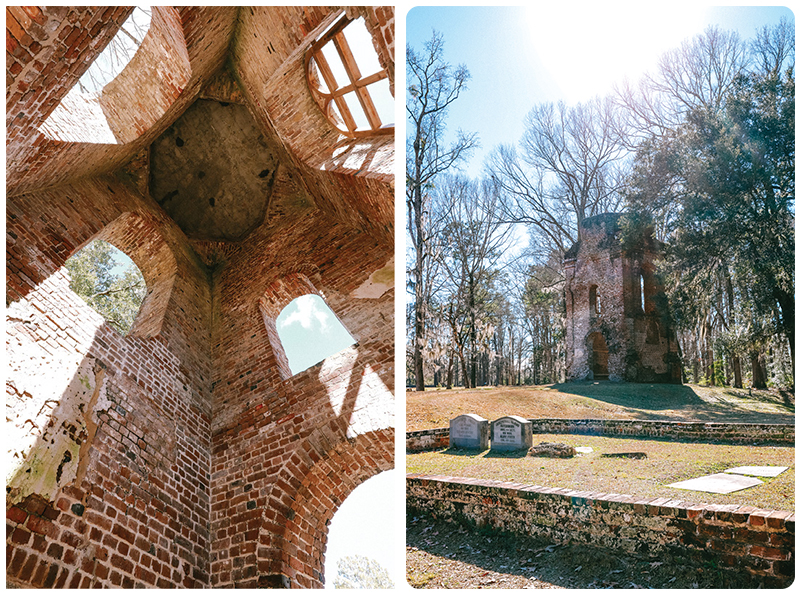
8. Colonial Dorchester State Historic Site
Summerville residents frequent this historic site and natural preserve along the Ashley River, but it’s off the radar of many Charlestonians. For a century, beginning in 1697, Dorchester was a bustling trading center that rivaled the Holy City in size and importance. Today, the walls of the fort that once guarded the town from intruders approaching on the river are the best-preserved example of oyster-shell tabby fortifications in the country. Just behind it, the brick bell tower of St. George’s Anglican Church has survived two major wars and the earthquake of 1886 since its construction in 1751. Take in history throughout the 325-acre grounds, including trails along the river, where you can imagine the wharf busy with activity in centuries past.
Take an archaeology tour of Colonial Dorchester:
300 State Park Rd., Summerville
Miles from Marion Square: 24
Admission: $3; $1.50 seniors; $1 kids ages six-15; free for ages five and younger
Amenities: parking, picnic tables, and restrooms
Learn more: southcarolinaparks.com/colonial-dorchester

9. Congaree National Park
Located near the tiny town of Hopkins, the largest remaining old-growth bottomland cypress forest in the US is now on the radar, thanks to its status as a national park, but it’s still surprisingly under-visited. The exception is during May, when the park’s rare species of synchronous fireflies put on their dazzling show during a brief two-week mating season (2021 Fireflies Festival access was still undetermined at press time due to COVID). Outside of May and Saturday afternoons, you’ll largely have the park to yourself.
A 2.6-mile boardwalk loop takes you deep into the waterlogged woods, and the Cedar Creek Canoe Trail lets visitors paddle a unique blackwater ribbon through a primeval forest. Off the boardwalk, don’t assume the hiking is easy because it’s flat. Check water levels with a park ranger—trekking through mud can significantly extend your hiking time. But the solitude, bird songs, and unfettered access to the world’s largest cypress trees make it all worth the effort.
Step into a forest of giants:
100 National Park Rd., Hopkins
Miles from Marion Square: 102
Admission: free
Amenities: parking, restrooms, free WiFi
Learn more: nps.gov/cong
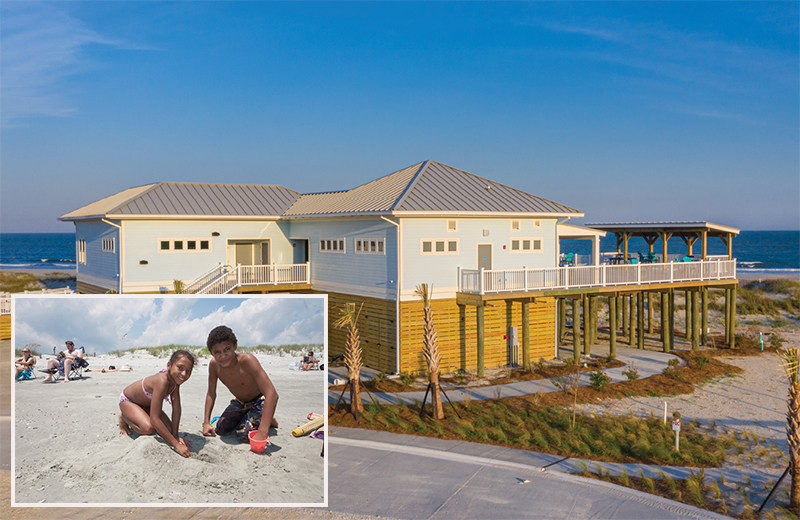
10. Folly Beach County Park
Folly Beach’s west tip may play second fiddle to the Morris Island Lighthouse at the east end, but its sunset views across the Stono River are unparalleled. And with the Folly Beach Pier closed and the new Dunes House visitor facility completed— with eight covered picnic tables, a snack bar, showers, and an expansive deck directly on the beach—2021 may be the county park’s big moment.
Walk to the island’s end, and you’ll have clear views of Bird Key and Skimmer Flats, each a rookery for shorebirds and pelicans. There’s also a calm beach along the Folly River where dolphins occasionally strand feed.
Vist Folly Beach County Parkl:
1100 W. Ashley Ave., Folly Beach
Miles from Marion Square: 12.8
Admission: $5-15 per car depending on the day of the week and month
Amenities: parking, restrooms, outdoor showers, picnic area, snack bar
Learn more: ccprc.com
Great Escapes
Need even more places to get away? Here are our other favorite outdoor adventures. (Visit the website for admission fees and amenities for each)
Photographs by Merry J. Plocki; (2) courtesy of Charleston Parks Conservancy; (oaks) Dave allen & (beach) Nickolay Khoroshkov; (2) by Samantha Zurbrick; (paddleboard) Roualeyn de Haas & (aerial) Nathan Bell & Courtesy of (tents) Woodlands Nature Reserve; (Spoonbill) Bonnie Taylor Barry & (Landscape) Keith Briley; (Trails-3) Amanda Bouknight & (sign) Daniel Barcelona; (Boardwalk) Lee Marion & (2) Lisa Greenslit; Amanda Bouknight; (woods) Natalia Bratslavsky & (owl) Michael Vodiansky; Courtesy of (Tree) Library of Congress; (pelican) Mike Truchon & (trees) Amanda Bouknight
& Courtesy Of (2) Charleston County Park & Recreation Commission